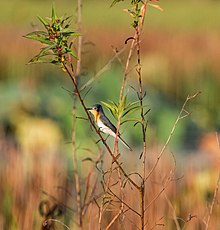
Fantails are small insectivorous songbirds of the genus Rhipidura in the family Rhipiduridae, native to Australasia, Southeast Asia and the Indian subcontinent. Most of the species are about 15 to 18 cm long, specialist aerial feeders, and named as "fantails", but the Australian willie wagtail is a little larger, and, though still an expert hunter of insects on the wing, concentrates equally on terrestrial prey.

The monarchs comprise a family of over 100 passerine birds which includes shrikebills, paradise flycatchers, and magpie-larks.

The paradise flycatchers (Terpsiphone) are a genus of birds in the family Monarchidae. The genus ranges across Africa and Asia, as well as a number of islands. A few species are migratory, but the majority are resident. The most telling characteristic of the genus is the long tail streamers of the males of many species. In addition to the long tails the males and females are sexually dimorphic and have rufous, black and white plumage.
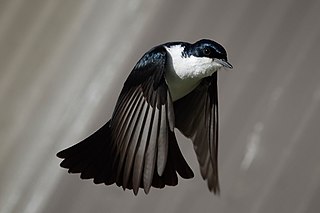
The restless flycatcher or restless myiagra is a passerine bird in the family Monarchidae; it is also known as the razor grinder or scissors grinder because of its distinctive call. It is a native of eastern and southern Australia. Populations in New Guinea and northern Australia, which were at one time considered to be a subspecies, are now accepted as a separate species, the paperbark flycatcher. It is a small to medium-sized bird and has similar colouring to the willie wagtail.
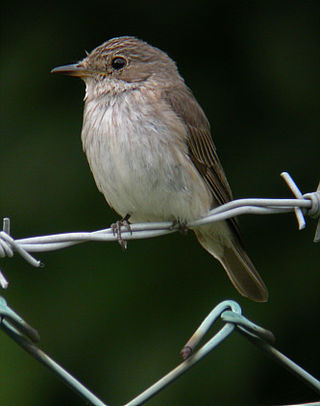
Muscicapa is a genus of passerine birds belonging to the Old World flycatcher family Muscicapidae, and therein to the typical flycatchers of subfamily Muscicapinae. They are widespread across Europe, Africa and Asia with most species occurring in forest and woodland habitats. Several species are migratory, moving south from Europe and northern Asia for the winter.

Drymophila is a bird genus in the antbird family (Thamnophilidae). It is a relative of the typical antwrens.

The shrikebills are the monarch flycatcher genus Clytorhynchus. The five species have long laterally compressed bills similar to true shrikes that give them their names. The genus is endemic to the islands of Melanesia and western Polynesia.

The celestial monarch is a species of bird in the family Monarchidae, and one of the most attractive of all the monarch flycatchers. It is identified as a turquoise blue bird with a long and spectacular cerulean blue crest and large greenish-yellow wattle. It is endemic to the Philippines with its extant range being in Luzon, Samar, Mindanao Tawi-Tawi and Basilan and it being possibly extinct on Negros and Sibuyan Island.Its natural habitat is tropical moist lowland forests up to 750 masl. There is an unverified report of this bird in 2024 in Leyte. It is one of the most sought after birds by birdwatchers in the Philippines and in the world.

The short-crested monarch is a species of bird in the family Monarchidae and one of the most attractive of all the monarch flycatchers. It is a brilliant ultramarine blue bird with the males having a black facial markings with an electric blue eyering and a short crest contrasted with a pearly white belly. It is endemic to the Philippines found on the islands of Luzon, Camiguin Norte, Polilio, Catanduanes, Samar, Dinagat and Mindanao. It is found in tropical moist lowland forest. It is threatened by habitat loss. It is one of the most sought after birds among birdwatchers.
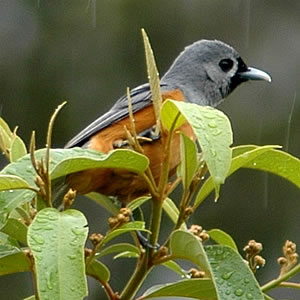
Monarcha is a genus of bird in the family Monarchidae. They are found in Australia and Melanesia.

The azure-crested flycatcher or the blue-crested flycatcher, is a species of bird in the monarch flycatcher family Monarchidae. It is endemic to Fiji, where it is found on Taveuni.
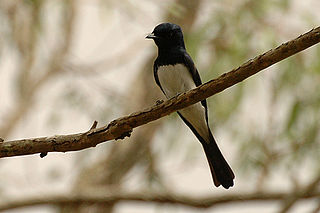
The satin flycatcher is a species of bird in the family Monarchidae. Males stand out with their blue-black feathers contrasting their white bellies, and the females with their bright orange throats. It breeds mostly in south-eastern Tasmania and Australia. It is declining throughout the eastern seaboard due to predation from the introduced Red Fox and habitat loss. It is a vagrant to New Zealand.
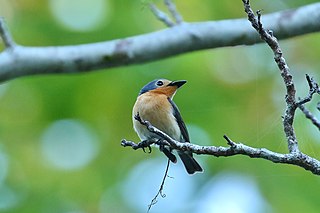
The Palau flycatcher is a species of bird in the family Monarchidae. It is endemic to Palau.
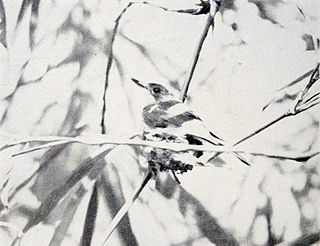
The Guam flycatcher, or Guam broadbill, is an extinct species of bird in the family Monarchidae formerly endemic to Guam.

The Chuuk flycatcher, formerly sometimes known as the oceanic flycatcher, is a species of bird in the family Monarchidae. It is endemic to Micronesia and can be found on the Caroline Islands. The diversity of traits in the Oceanic flycatchers resulted from three waves of colonization in non-overlapping times, which led to situ specification events on Micronesian islands.

The leaden flycatcher is a species of passerine bird in the family Monarchidae. Around 15 cm (6 in) in length, the male is lustrous azure with white underparts, while the female possesses leaden head, mantle and back and rufous throat and breast. It is found in eastern and northern Australia, Indonesia, and Papua New Guinea. Its natural habitat is subtropical or tropical mangrove forests in the northern parts of its range, in the south and inland it is eucalypt woodland.
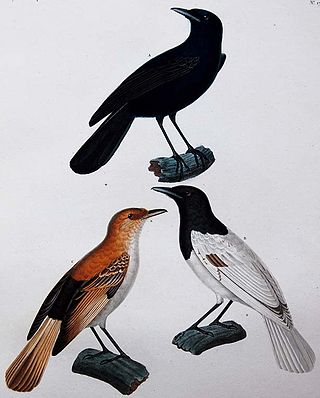
Pomarea is a genus of birds in the monarch flycatcher family Monarchidae. The genus is restricted to the islands of Polynesia. The monarchs of this genus are around 15–19 cm long and most have sexually dimorphic plumage.

Trochocercus is a genus of bird in the family Monarchidae. Described by Jean Cabanis in 1850, the name Trochocercus is a combination of the Greek words trokhos meaning "circular" or "round" and kerkos, meaning "tail".

The pale-blue monarch is a small passerine bird in the family Monarchidae endemic to eastern Indonesia.

